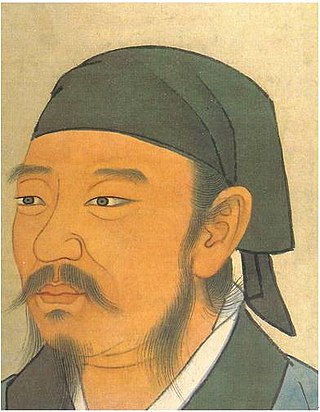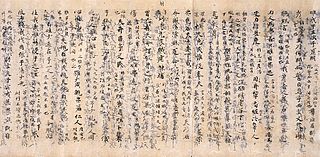
Confucianism, also known as Ruism or Ru classicism, is a system of thought and behavior originating in ancient China, and is variously described as a tradition, philosophy, religion, theory of government, or way of life. Confucianism developed from teachings of the Chinese philosopher Confucius (551–479 BCE), during a time that was later referred to as the Hundred Schools of Thought era. Confucius considered himself a transmitter of cultural values inherited from the Xia (c. 2070–1600 BCE), Shang (c. 1600–1046 BCE) and Western Zhou dynasties (c. 1046–771 BCE). Confucianism was suppressed during the Legalist and autocratic Qin dynasty (221–206 BCE), but survived. During the Han dynasty, Confucian approaches edged out the "proto-Taoist" Huang–Lao as the official ideology, while the emperors mixed both with the realist techniques of Legalism.

Chinese philosophy originates in the Spring and Autumn period and Warring States period, during a period known as the "Hundred Schools of Thought", which was characterized by significant intellectual and cultural developments. Although much of Chinese philosophy begun in the Warring States period, elements of Chinese philosophy have existed for several thousand years. Some can be found in the I Ching, an ancient compendium of divination, which dates back to at least 672 BCE.

Confucius, born Kong Qiu (孔丘), was a Chinese philosopher of the Spring and Autumn period who is traditionally considered the paragon of Chinese sages. Confucius's teachings and philosophy underpin the East Asian culture and society, and remain influential across China and East Asia to this day. His philosophical teachings, called Confucianism, emphasized personal and governmental morality, correctness of social relationships, justice, kindness, sincerity, and a ruler's responsibilities to lead by virtue.
The Chinese classics or canonical texts are the works of Chinese literature authored prior to the establishment of the imperial Qin dynasty in 221 BC. Prominent examples include the Four Books and Five Classics in the Neo-Confucian tradition, themselves an abridgment of the Thirteen Classics. The Chinese classics used a form of written Chinese consciously imitated by later authors, now known as Classical Chinese. A common Chinese word for "classic" literally means 'warp thread', in reference to the techniques by which works of this period were bound into volumes.
The Great Learning or Daxue was one of the "Four Books" in Confucianism attributed to one of Confucius' disciples, Zengzi. The Great Learning had come from a chapter in the Book of Rites which formed one of the Five Classics. It consists of a short main text of the teachings of Confucius transcribed by Zengzi and then ten commentary chapters supposedly written by Zengzi. The ideals of the book were attributed to Confucius, but the text was written by Zengzi after his death.

The Analects, also known as the Sayings of Confucius, is an ancient Chinese philosophical text composed of sayings and ideas attributed to Confucius and his contemporaries, traditionally believed to have been compiled by his followers. The consensus among scholars is that large portions of the text were composed during the Warring States period (475–221 BC), and that the work achieved its final form during the mid-Han dynasty. During the early Han, the Analects was merely considered to be a commentary on the Five Classics. However, by the dynasty's end the status of the Analects had grown to being among the central texts of Confucianism.

The Classic of Poetry, also Shijing or Shih-ching, translated variously as the Book of Songs, Book of Odes, or simply known as the Odes or Poetry, is the oldest existing collection of Chinese poetry, comprising 305 works dating from the 11th to 7th centuries BC. It is one of the "Five Classics" traditionally said to have been compiled by Confucius, and has been studied and memorized by scholars in China and neighboring countries over two millennia. It is also a rich source of chengyu that are still a part of learned discourse and even everyday language in modern Chinese. Since the Qing dynasty, its rhyme patterns have also been analysed in the study of Old Chinese phonology.

Xunzi, born Xun Kuang, was a Chinese philosopher of Confucianism during the late Warring States period. After his predecessors Confucius and Mencius, Xunzi is often ranked as the third great Confucian philosopher of antiquity. By his time, Confucianism had suffered considerable criticism from Daoist and Mohist thinkers, and Xunzi is traditionally regarded as a synthesizer of these traditions with earlier Confucian thought. The result was a thorough and cohesive revision of Confucianism, which was crucial to the philosophy's ability to flourish in the Han dynasty and throughout the later history of East Asia. His works were compiled in the eponymous Xunzi, and survive in excellent condition. Unlike other ancient compilations, his authorship of these texts is generally secure, though it is likely that Western Han Dynasty historian Liu Xiang organized them into their present form centuries after Xunzi's death.

The Book of Documents or the Classic of History, is one of the Five Classics of ancient Chinese literature. It is a collection of rhetorical prose attributed to figures of ancient China, and served as the foundation of Chinese political philosophy for over two millennia.

The Book of Rites, also known as the Liji, is a collection of texts describing the social forms, administration, and ceremonial rites of the Zhou dynasty as they were understood in the Warring States and the early Han periods. The Book of Rites, along with the Rites of Zhou (Zhōulǐ) and the Book of Etiquette and Rites (Yílǐ), which are together known as the "Three Li (Sānlǐ)," constitute the ritual (lǐ) section of the Five Classics which lay at the core of the traditional Confucian canon. As a core text of the Confucian canon, it is also known as the Classic of Rites or Lijing, which some scholars believe was the original title before it was changed by Dai Sheng.

Zisi, born Kong Ji (孔伋), was a Chinese philosopher and the grandson of Confucius.
The Four Books and Five Classics are authoritative and important books associated with Confucianism, written before 300 BC. They are traditionally believed to have been either written, edited or commented by Confucius or one of his disciples. Starting in the Han dynasty, they became the core of the Chinese classics on which students were tested in the Imperial examination system.
The rectification of names is originally a doctrine of feudal Confucian designations and relationships, behaving accordingly to ensure social harmony. Without such accordance society would essentially crumble and "undertakings would not be completed." Mencius extended the doctrine to include questions of political legitimacy.

The Yu Gong or Tribute of Yu is a chapter of the Book of Xia section of the Book of Documents, one of the Five Classics of ancient Chinese literature. The chapter describes the legendary Yu the Great and the provinces of his time. Most modern scholars believe it was written in the fifth century BCE or later.

Mao Qiling was a Chinese scholar and philologist of the early Qing dynasty. A native of Xiaoshan in Zhejiang province, he became a licentiate at the age of fifteen sui. After the fall of the Ming dynasty in 1644, he refused to serve the Qing. In 1679, however, he took part in and passed a special honorary examination held by the Kangxi Emperor to attract scholars who had not yet announced their allegiance to the new dynasty. He was then appointed to the compilation of the official History of Ming. After retiring from office in 1687, he went to live in Hangzhou (Zhejiang), where he taught many disciples.
The Four Sages, Assessors, or Correlates, are four eminent Chinese philosophers in the Confucian tradition. They are traditionally accorded a kind of sainthood and their spirit tablets are prominently placed in Confucian temples, two upon the east and two upon the west side of the Hall of the Great Completion.
De l'un au multiple: Traductions du chinois vers les langues européennes Translations from Chinese into European Languages is an academic book in French and English with essays about translations of Chinese into European languages. It was published in 1999 by the Éditions de la MSH, Fondation Maison des sciences de l'homme, and edited by Viviane Alleton and Michael Lackner. The introduction states that the purpose of this work is to examine specific issues in translation from Chinese to European languages and from the Chinese culture to Western cultures, instead of promoting a new theory regarding translation.
Yuan Xian, courtesy name Zisi or Yuan Si, was a Chinese philosopher who was a major disciple of Confucius. Classic Chinese sources stated he was modest and incorruptible, and adhered strictly to the teachings of Confucius despite living in abject poverty.

Zeng Dian, courtesy name Zixi, also known as Zeng Xi, was one of the earliest disciples of Confucius. He is known for a passage in the Analects in which he expressed his ambition as no more than being content with daily life. He was the father of Zeng Shen, or Master Zeng, one of the most prominent disciples of Confucius.
Xing Zi Ming Chu, translated as Human Nature Is Brought Forth by Decree or The Inborn-Nature Comes from the Mandate, is a Warring States period text from the Kingdom of Chu, excavated in 1993 from the Guodian tomb, near Jingmen in Hubei, China. It is one of the earliest Chinese texts to discuss human nature, although it was lost until its re-discovery.














